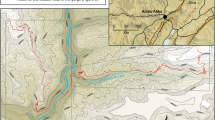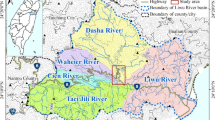Abstract
This paper reports the use of geomorphological mapping to obtain a better understanding of the terrain for the Lower Kihansi Dam Access Road in the Udzungwa Mountains. The long-term accessibility of the road and protection of the natural resources of the area were pre-conditions for the construction of this road, which was primarily to facilitate the transportation of equipment, machinery and personnel during construction of a 54,000 m3 concrete gravity dam related to a 180-MW hydropower station. Black and white vertical aerial photographs supplemented with field mapping were used to prepare a 1 : 5,000 geomorphological map of a possible route corridor. The mapping identified areas with unfavourable ground conditions which were subsequently studied and characterized in order to select the final route. In sections where it was not possible to deviate the road from the unfavourable areas, protection and stabilization measures were considered during the design and construction phases. The road was constructed successfully and without causing damage to the environment. Geomorphological mapping proved to be a useful tool in selecting the optimum route and appropriate construction method.
Résumé
L’article présente comment la cartographie géomorphologique a permis d’aider au choix du tracé de la route d’accès au barrage de Kihansi aval, dans les montagnes de Udzungwa. L’accessibilité de cette route à long terme et la protection des ressources naturelles de la région ont présidé au choix du tracé. Cette route a pour première fonction de permettre le transport des équipements et du matériel ainsi que du personnel pendant la construction du barrage poids en béton de 54000 m3, qui alimente une centrale hydroélectrique de 180 MW. Des photographies aériennes panchromatiques en appui à des travaux cartographiques de terrain ont permis d’établir la carte gèomorphologique au 1/5000 d’un possible fuseau pour cette route. Cette cartographie a mis en évidence les zones de terrain défavorable qui ont fait l’objet d’études complèmentaires afin de décider du choix final du tracé. Pour les sections où les zones de terrain défavorable ne pouvaient être évitées, des techniques de protection ou de stabilisation des terrains ont été définies en phase de conception et mises en œuvre durant la construction. La route a été construite avec succès et sans créer de dommage à l’environnement. La cartographie géomorphologique a montré sa capacité à contribuer au choix d’un tracé routier et à celui de méthodes de construction adaptées.


Similar content being viewed by others
References
Beaven PJ, Lawrance CJ (1982) Terrain evaluation for highway planning and design. TRRL Rep 892:36–45
BS 5930 (1981) Code of practice for site investigations. British Standards Institution. Formerly CP 2001, p 142
Cooke RU, Doornkamp JM (1990) Geomorphology in environmental management, 2nd edn. Clarendon Press, Oxford
Crozier MJ (1984) Field assessment of slope instability. In: Brunsden D, Prior DB (eds) Slope instability. Wiley, Chichester, pp 103–142
Deoja BB, Dhital MR, Andhar KC, Wagner A (1991) Risk engineering in the Hindu-Kush Himalaya. International Centre for Mountain Intergrated Development, Kathmandu
Ives JD, Messerli B (1990) The Himalayan Dilemma. Reconciling development and conservation. Routledge, London
Lawrance CJ, Cook JR (2003) A strategy for slope hazard assessment in road planning and maintenance. World Road Association (PIARC). Technical Committee C12. Seminar in Nepal. TRL Ltd. PA3945/03
Lovett JC (1990) Classification and status of the moist forests of Tanzania. Mitteilungen aus dem Institut für Allgemeine Botanik Hamburg 23:287–300
Lumb P (1975) Slope failures in Hong Kong. Q J Eng Geol 8(1):31–65
Mruma AH (2000) Geological conditions at the Lower Kihansi Hydropower Project area. In: Workshop on Underground and Geotechnical Work. Lower Kihansi Hydropower Project. 19–20 June 2000, p 18
Myers N, Lovett JC, Burgess ND (1999) Eastern arc mountains and coastal forests. In: Mittermeier RA, Meyers N, Robles Gil P, Mittermeier CG (eds) Hotspots: Earth’s Biologically Richest and Most Endangered Terrestrial Ecoregions. CEMEX, Mexico, pp 218–227
Norplan A/S (1995) Dam access road: design criteria and guidelines for detailed design. Lower Kihansi Hydropower Project
Numan NMS, Al-Barany SK (1995) Highway route selection in Northern Iran using terrain evaluation from aerial photographs. ITC J 1995–2, pp 120–126
Rapp A, Axelsson V, Berry L, Murray-Rust DH (1972) Soil erosion and sediment transport in the Morogoro river catchment, Tanzania. Geogr Ann 54A:3–4, pp 125–155, UUGI A 256
Roti JA (2000) Dam Design and Dam Access Road. In: Workshop on Underground and Geotechnical Work. Lower Kihansi Hydropower Project. 19–20 June 2000
Summerfield M (1996) Global geomorphology. An introduction to the study of landforms. Prentice Hall, New York, p 560
Author information
Authors and Affiliations
Corresponding author
Rights and permissions
About this article
Cite this article
Marwa, E.M.M., Kimaro, D.N. Geomorphological mapping for route selection and road construction at lower Kihansi in Tanzania. Bull Eng Geol Environ 64, 333–339 (2005). https://doi.org/10.1007/s10064-005-0012-3
Received:
Accepted:
Published:
Issue Date:
DOI: https://doi.org/10.1007/s10064-005-0012-3




